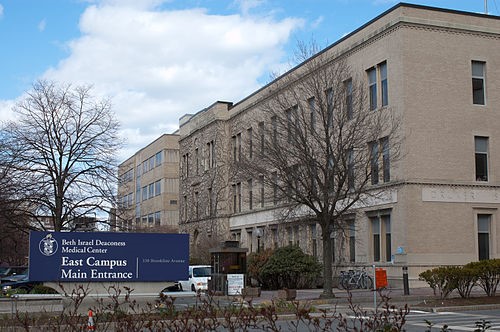博文
西兰花中发现的天然化合物能唤醒强大的肿瘤抑制功能
|||
西兰花中发现的天然化合物能唤醒强大的肿瘤抑制功能

贝斯以色列女执事医疗中心(Beth Israel Deaconess Medical Center,简称BIDMC)是一个位于美国马萨诸塞州波士顿的国际知名医疗中心,是哈佛医学院主要的教学医院。它的前身是“贝斯以色列医院”(1916年成立)和“新英格兰女执事医院”(1896年成立),1996年两所医院合并。在独立的教学医院中,贝斯以色列女执事医疗中心从美国国家卫生研究院(National Institutes of Health, NIH)所接受的生物医学研究资金名列第三位,每年接近1.5亿美元。贝斯以色列女执事医疗中心的研究人员超过1000名。贝斯以色列女执事医疗中心坐落在长木医学区,是马萨诸塞Caregroup Healthcare System的旗舰医院,一向被美国U.S. News & World Report列为美国最好的医院之一。它是新英格兰最大的医院之一,仅次于均位于波士顿的麻省总医院(Massachusetts General Hospital;Mass General或MGH)和布莱根妇女医院(Brigham and Women's Hospital,BWH)。 贝斯以色列女执事医疗中心发展史上的里程碑是1922年在英格兰首次注射胰岛素以及1960年首次植入心脏起搏器。该医疗中心2019年5月17日在《科学》(Science)杂志网站发表文章指出,西兰花中的天然产物能够唤醒强大的肿瘤抑制功能——Yu-Ru Lee, Ming Chen, Jonathan D. Lee, Jinfang Zhang, Shu-Yu Lin, Tian-Min Fu, Hao Chen, Tomoki Ishikawa, Shang-Yin Chiang, Jesse Katon, Yang Zhang, Yulia V. Shulga, Assaf C. Bester, Jacqueline Fung, Emanuele Monteleone, Lixin Wan, Chen Shen, Chih-Hung Hsu, Antonella Papa, John G. Clohessy, Julie Teruya-Feldstein, Suresh Jain, Hao Wu, Lydia Matesic, Ruey-Hwa Chen, Wenyi Wei, Pier Paolo Pandolfi. Reactivation of PTEN tumor suppressor for cancer treatment through inhibition of a MYC-WWP1 inhibitory pathway. Science, 17 May 2019: Vol. 364, Issue 6441, eaau0159. DOI: 10.1126/science.aau0159

西兰花
妈妈会经常告诉孩子,西兰花对你的健康有好处。西兰花和其他十字花科植物,包括花椰菜、卷心菜、羽衣甘蓝、抱子甘蓝和甘蓝等,长期以来都与降低患癌症的风险有关。这些十字花科植物含有一种分子,可以使一种已知在多种常见人类癌症中发挥作用的基因失去活性。2019年5月17日发表于《科学》杂志的一篇新论文,由美国哈佛医学院贝斯以色列女执事医疗中心癌症中心癌症研究所(Cancer Research Institute, Beth Israel Deaconess Cancer Center, Harvard Medical School)主任Pier Paolo Pandolfi博士,与来自美国、印度、意大利、澳大利亚、中国浙江大学医学院和台湾大学生命科学院生化科学研究所、台湾中央研究院生化研究所的科研人员合作完成,表明目标基因-WWP1, 西兰花中发现的成分能够抑制癌变实验室动物的肿瘤生长。
Pier Paolo Pandolfi博士说:“我们发现了一种新的重要分子,它可以驱动癌症发展的关键途径,这种酶可以被西兰花和其他十字花科蔬菜中的一种天然化合物抑制。”“这一途径不仅作为肿瘤生长控制的调节剂出现,而且是我们可以用治疗方案瞄准的致命弱点。”
PTEN基因是人类肿瘤中最常见的突变、缺失、下调或沉默的抑癌基因之一,是一种众所周知的高效抑癌基因。某些遗传性PTEN突变可导致以癌症易感性和发育缺陷为特征的综合症。但是,由于该基因的完全丧失会触发一种不可逆的、强有力的故障保险机制,从而阻止癌细胞的增殖,所以该基因的两个拷贝(人类每个基因都有两个拷贝;来自父母双方的一个)很少被影响。相反,肿瘤细胞表现出较低水平的PTEN,这就提出了一个问题:在癌症环境中,将PTEN活性恢复到正常水平是否能够释放该基因的抑癌活性。为了找到答案,Pier Paolo Pandolfi博士和他的同事确定了调节PTEN功能和激活的分子和化合物。研究小组在易患癌症的小鼠和人类细胞中进行了一系列实验,发现一种名为WWP1的基因会产生一种酶,抑制PTEN的抑癌活性。如何禁用这个PTEN的克星?就是需要研究解决的难题。通过分析这种酶的物理形状,研究小组的化学家们认识到,一种名为吲哚-3-甲醇(indole-3-carbinol, I3C)的小分子可能是抑制WWP1致癌作用的关键。吲哚-3-甲醇是西兰花及其十字花科蔬菜中一种主要的有效植物化学物质,具有防癌和抗癌作用。
当Pier Paolo Pandolfi博士和他的同事通过给易患癌症的实验动物注射I3C来测试这个想法时,科学家们发现西兰花中天然的成分使WWP1失去活性,从而释放了PTEN抑制肿瘤的能力。
先别忙著去农贸市场購買西蘭花等十字花科蔬菜;第一作者李玉儒(Yu-Ru Lee音译)博士是Pier Paolo Pandolfi实验室的成员,他指出,为了获得潜在的抗癌益处,你必须每天吃近6磅的球芽甘蓝——而且是生的。这就是为什么Pier Paolo Pandolfi研究团队正在寻找其他方法来利用这些新知识的原因。该团队计划进一步研究WWP1的功能,最终的目标是开发更有效的WWP1抑制剂。
Pier Paolo Pandolfi博士说:“无论是基因上还是药物上,利用CRISPR技术或I3C使WWP1失活,都可以恢复PTEN的功能,并进一步释放其肿瘤抑制活性。”“这些发现为长期寻求的肿瘤抑制因子活化疗法铺平了道路。” 更多信息请注意浏览原文或者相关报道。
Abstract
Activation of tumor suppressors for the treatment of human cancer has been a long sought, yet elusive, strategy. PTEN is a critical tumor suppressive phosphatase that is active in its dimer configuration at the plasma membrane. Polyubiquitination by the ubiquitin E3 ligase WWP1 (WW domain–containing ubiquitin E3 ligase 1) suppressed the dimerization, membrane recruitment, and function of PTEN. Either genetic ablation or pharmacological inhibition of WWP1 triggered PTEN reactivation and unleashed tumor suppressive activity. WWP1 appears to be a direct MYC (MYC proto-oncogene) target gene and was critical for MYC-driven tumorigenesis. We identified indole-3-carbinol, a compound found in cruciferous vegetables, as a natural and potent WWP1 inhibitor. Thus, our findings unravel a potential therapeutic strategy for cancer prevention and treatment through PTEN reactivation.
Supporting tumor suppression
The protein PTEN is a phosphatase and tumor suppressor whose activity is often decreased in human cancers. Thus, reactivating such a protein could potentially be an effective therapy against cancer. Lee et al. identified a ubiquitin E3 ligase (WWP1) as a PTEN-interacting protein that modifies PTEN and inhibits its tumor suppressive activity (see the Perspective by Parsons). Depletion of WWP1 increased dimerization and membrane recruitment of PTEN. A natural compound found to be a pharmacological inhibitor of WWP1 inhibited tumor growth in a mouse model of prostate cancer. Thus, reactivation of the tumor suppressor PTEN may provide a strategy for battling tumors.
Science, this issue p. eaau0159; see also p. 633
Structured Abstract
INTRODUCTION
Inhibition of oncogenic proteins represents a mainstay approach for cancer therapeutic development. By contrast, pharmacological modulation of tumor suppressor activity for the treatment of cancer has remained elusive. PTEN is a potent tumor suppressor gene, antagonizing the proto-oncogenic phosphoinositide 3-kinase (PI3K)–AKT signaling pathway and governing fundamental cellular processes. Cancer cells cannot afford to lose complete PTEN activity prematurely, because this would trigger cellular senescence, making PTEN an “obligate haploinsufficient” tumor suppressor gene. For this reason, PTEN is frequently dysregulated through monoallelic loss, aberrant subcellular localization, and/or posttranslational modification in human cancers as well as in cancer susceptibility syndromes such as PTEN hamartoma tumor syndrome (PHTS). Because PTEN overexpression in mice results in a tumor-suppressive metabolic state and life-span extension, the identification of molecular mechanisms to activate and reactivate PTEN function would offer important therapeutic opportunities for human health.
RATIONALE
Although PTEN dimer formation and recruitment at the plasma membrane are indispensable for its function and activation, the mechanisms regulating these processes remain unknown. We thus sought to identify upstream regulators of PTEN dimerization and membrane localization, inhibition of which may restore PTEN activity and provide therapeutic opportunities against cancer.
RESULTS
Through immunoprecipitation followed by mass spectrometry analysis, we identified the HECT-type E3 ubiquitin ligase WWP1 as a physical PTEN interactor. We found that WWP1 specifically triggers nondegradative K27-linked polyubiquitination of PTEN to suppress its dimerization, membrane recruitment, and tumor-suppressive functions both in vitro and in vivo.
WWP1 is genetically amplified and frequently overexpressed in multiple cancers, including those of prostate, breast, and liver, which may lead to pleiotropic inactivation of PTEN. We found that WWP1 may be transcriptionally activated by the MYC proto-oncogene and that genetic depletion of Wwp1 in both Myc-driven mouse models of prostate cancer in vivo and cancer cells in vitro reactivates PTEN function, leading to inhibition of the PI3K-AKT pathway and MYC-driven tumorigenesis. Depletion of Wwp1 significantly reduced PI3K-AKT activity in mouse fibroblasts harboring monoallelic PTEN or PTEN mutations, as observed in PHTS patients. These findings demonstrate that WWP1 acts downstream of MYC and that perturbation of WWP1 is sufficient to restore PTEN tumor-suppressive activity.
We next identified indole-3-carbinol (I3C), a derivative of cruciferous vegetables, as a natural and potent WWP1 inhibitor through structure simulation and biochemical analyses. Pharmacological inactivation of WWP1 by I3C in either Myc-driven or Pten heterozygous mice reactivates PTEN, leading to potent suppression of tumorigenesis driven by the PI3K-AKT pathway. Therefore, genetic or pharmacological targeting of the WWP1-PTEN axis holds promise for patients affected by a number of cancers and other disorders associated with germline mutations of the PTEN gene.
CONCLUSION
We have identified the MYC-WWP1 axis as a fundamental and evolutionary conserved regulatory pathway for PTEN and PI3K signaling. This pathway emerges not only as a rheostat for growth control in physiological conditions but also as a critical vulnerability hijacked for neoplastic transformation, which may be reversed by WWP1 pharmacological inactivation. These findings pave the way toward a long-sought tumor suppressor “reactivation” approach to cancer treatment. Because an increased expression level of MYC-WWP1 or PTEN impairment is widely pervasive in various human cancers, targeting this pathway toward PTEN reactivation may represent an “Achilles heel” of broad application.
Model for WWP1-mediated PTEN K27-linked polyubiquitination in tumor development and progression.
Deregulated MYC overexpression or MYC amplification promotes WWP1 expression and, in turn, triggers PTEN K27-linked polyubiquitination. Aberrant K27-linked polyubiquitination suppresses PTEN dimerization, plasma membrane recruitment, and tumor suppressive function, leading to tumor initiation and progression. Pharmacological inactivation of WWP1 by I3C, a derivative of cruciferous vegetables, reactivates PTEN, leading to suppression of tumorigenesis. PIP2, phosphatidylinositol 4,5-bisphosphate; PIP3, phosphatidylinositol 3,4,5-trisphosphate; u, ubiquitin.
https://blog.sciencenet.cn/blog-212210-1180079.html
上一篇:突破性的基因发现揭示了狼疮发生的原因
下一篇:千克标准Le grand K退休,h代之重新定义
